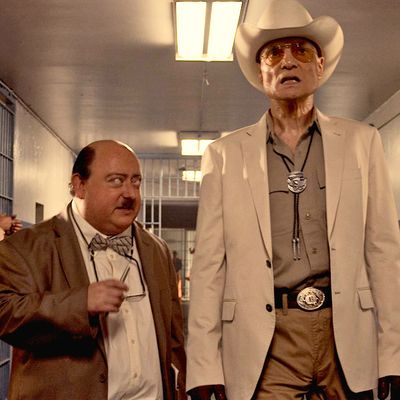
No. Nope. Uh-uh. In case you were expecting director Tom Six’s sicko human-anus-to-mouth-stitching horror saga to suddenly become better, or at least tolerable, by its third installment, let me just shatter your dreams right now. Human Centipede 3 is the worst of the lot. Is that even possible? Apparently, it is. Maybe it’s because it’s also the most ambitious — ambitious in a way that undermines the earlier films’ peculiarly chilly and disquieting world view, their … wait, integrity can’t possibly be the word I’m looking for, can it? Let me put it this way: I suspect that even those who consider themselves fans of the Human Centipede franchise will feel betrayed by this outing.
This time, the setting is a prison, run by a wide-eyed, bellowing cartoon-demon of a warden named Bill Boss (played by Dieter Laser, who played the demented visionary Doctor Heiter in the first film). When we first see him, he’s being made to watch Human Centipede 2 by his mousy, perpetually nervous assistant Dwight (Laurence Harvey, who was in the second film), a pudgy technocrat with a Hitler mustache. “I told you this film would be shit, and it literally is shit!” Boss yells to Dwight, but don’t let that fool you; he might not be a fan of Mr. Six’s oeuvre, but he is himself one torquemadastically sick fuck. “I believe in bringing back medieval torture methods,” he snarls. “Reverse hanging, Spanish boots, the good old rack … Poison spiders for prisoners with arachnophobia!”
And we actually get to see him do some of his stuff, or variations on it, at least. Boss waterboards a prisoner with boiling water (or, as he calls it, “booooooooiiiillling waater!”). Later, he cuts out another prisoner’s testicles and hands them to a minion: “Bring these little motherfuckers to the cook. I want them meeeeeeddddiiiuum raaare for lunch!” he yawps, while covering his face with blood (which raises the question, “Why not just rare?”). He’s like Dracula meets Josef Mengele meets Tommy Wiseau. When he has nightmares, it’s of prisoners revolting, carving a hole in his torso, and fucking him in the kidneys. Oh, and on his office desk is a jar of fried African clitorises on which he likes to snack.
Here, I’ll start a new paragraph so that you can take a break to go throw up.
But wait, you might be thinking right about now. Where’s the human centipede?? I was promised a human centipede! Don’t worry. Six might be a lousy director, but he’s a brilliant marketer. The centipede in question is hinted at, teased, throughout the film, but we don’t really see it until the end. (Oh no! Did I spoil it for you?) For all of Boss’s sadism, he consistently refuses the centipede option being suggested by the nervous Dwight, who is obsessed with cutting costs and making the prison system work more efficiently. Dwight is convinced that a human centipede — one designed so that prisoners could be removed when their sentence ends — might be a real breakthrough. Not only would you save money on food, water, books, and housing, but the awfulness of the punishment could be a real deterrent, too, thus reducing recidivism. The movie depicts the long, slow process whereby the ruthless accountant and the impulsive, snarling sadist finally get on the same page. Along the way, they consult with … Tom Six himself. The director, playing himself, visits the prison, driving a convertible and sporting movie star shades, and signs autographs for the starstruck staff. That’s the one good joke in the whole movie.
It’s all meant to be symbolic, of course, and Six (as director) makes sure everything is played out as broadly as possible, in case you miss the point. You’re not going to miss the point. A messy, opportunistic kind of politics is smeared all over this thing. Boss loves to yell racial epithets, and he’s unusually fixated on prisoners’ religions. More important, he loves to announce his patriotism. When the governor (played by Eric Roberts, because why the hell not?) visits the prison and pulls out a Cuban cigar, Boss wraps himself in the American flag and denounces him for his lack of patriotism. The Star-Spangled Banner plays over the film’s final shot. And, of course, the specter of real-life crimes like those at Abu Ghraib prison loom large, as they do over much of the torture porn genre.
Unfortunately, Six’s talents don’t match his ambitions. They never really did, but they’re especially wanting here. With a broader canvas, and more characters, his inability to convincingly stage a scene shows. Eyelines don’t match; at times we can’t tell who’s talking to whom. Characters seem to look off into space, when it turns out they’re actually looking at each other. The filmmaking is strictly amateur hour, which is particularly deadly when it comes to satire. Meanwhile, the cast can’t quite pull off the broad performances. One wonders if they’re going this big as a way to cope with the monstrousness of what’s onscreen. If so, that actually says something encouraging about their humanity. (About halfway through the film, I realized I would be way more interested in a film about the making of Human Centipede 3 than I was in Human Centipede 3. But I don’t want to give Six any ideas.)
In the earlier films — the austere and forlorn first installment, and the garish, gruesome second — Six could hide behind the queasy mood and our own revulsion. Now, however, he’s gone bold and colorful, and the daylight hurts: This is a big movie — in themes, in performances, in outrage. Six has got things to say, and he wants to command our attention. But he should be careful what he wishes for. The more we look, the less we see.


